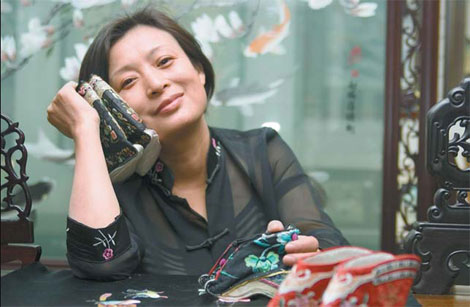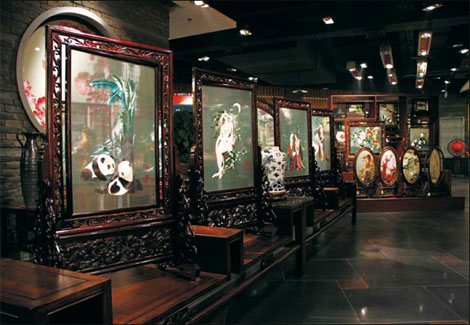

 |
|
Zhong Bingzhang is curator of the Chengdu Shu Brocade and Embroidery Museum. |
 |
|
Exhibits present Shu brocades and embroideries at the museum. |
Shu brocades' trade was so important that the Western Han emperors appointed an official with the title Brocade Officer. His role was supervise the highly lucrative industry that operated more than 200,000 looms in its heyday.
Tsinghua University professor Huang Nengfu likens the Brocade Officer to today's minister of textiles.
Since that time, Chengdu has been known as "Brocade City" and the city moat, in which brocades were soaked to preserve their colors, is called the "Brocade River".
Chengdu had more than 2,000 private workshops and more than 10,000 looms producing brocades in the Qing era.
Chengdu set up the State-owned Chengdu Shu Brocade Factory in 1951. It employed more than 2,000 weavers.
The factory specialized in mass-producing silk for clothing and bedcovers.
"It introduced mechanical production in the early 1960s because manual weaving cost more time and money," 84-year-old weaver Xie Huiru, who started learning brocade-making at age 9, recalls.
The factory's products sold well from the early 1950s to the early '90s. Market changes in 1995 put the factory out of business a year later.
Sichuan natives would present newlyweds brocaded bedcovers featuring images of dragons (representing men) and phoenixes (representing women). But the tradition faded with the growing popularity of duvets.
Zhong Bingzhang, chief of the general office of the State-owned Chengdu Silk Corporation, which oversaw the city's silk industry, worried the tradition might vanish entirely.
So she began visiting the bankrupt factory's technicians and workers to find a solution.
Her research culminated in a report sent to Chengdu's then mayor, Li Chuncheng, in 2002.
Zhong's proposal was to use tourism and marketable products to preserve the ancient skill. After the municipal government endorsed Zhong's report, she opened the Shu Brocade Institute at the site of the former Chengdu Shu Brocade Factory.
The brand, which literally translates as "River of Sichuan", comes from what Japanese students studying in China in the Tang Dynasty (AD 618-907) called the brocades they took home, Tu says.
Zhong invited several elderly weavers from the out-of-business factory to manually weave in the academy. Most were older than 70, because the number of people who could still do such work "could be counted on two hands".
It's monotonous. It often takes an entire day to weave 5-6 cm.
"I once spent a week finishing a brocade piece the size of a small handkerchief," He Bin, a 47-year-old who works as weaver in the museum, says.
Xie says the only reason he started weaving was to earn rice. He had been orphaned a year before he started working the looms.
Zhong has been hunting for new students to learn from masters like Xie among underprivileged families in Sichuan's economically distressed city of Xichang, where silk production remains a pillar industry. She believes Xichang residents are exceptionally hardworking, she says.
The more marketable new brocades can be used for interior decorations, fashion designs and luxury goods, Zhong says.
The academy has enjoyed a growing number of visitors, and its annual sales now surpass 20 million yuan ($3.14 million).
Zhong also established four Shujiang Brocade shops along the city's busy business streets and near tourism sites.
But the 30 million-yuan museum remains the centerpiece of Shu brocades' preservation - the main thread that holds this tradition together in modern times.

In China, most giant pandas live in the mountains of Qinling, Minshan, Qionglai, Daxiangling and Xiaoxiangling.

By the end of 2011, the number of wild giant pandas in the world was about 1,590.